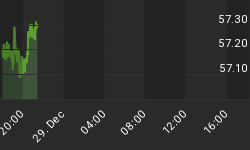The good news is:
Most of the major indices as well as both the NASDAQ and NYSE advance-decline lines hit new cycle highs last week. The implication is there should be further highs in, at least, the blue chip indices in the next 2-6 weeks.
After hitting new highs the market went on to develop a topping pattern including:
1) The secondaries under performing the blue chips.
2) A rapid decline in new highs.
3) A build up of declining volume.
The first chart I have shown before. It is a FastTrack chart showing the Russell 2000 (R2K), S&P 500 (SPX), and a relative strength indicator called Accutrack. I have drawn a line across the peaks in the R2K. Since late September the market has been moving in a cyclical pattern lasting about one month. The cycle peaked early last week as the R2K hit its upper trend line. If the pattern holds, the downside leg should last at least a week.

The second chart shows the NASDAQ composite along with a 10% trend of NASDAQ new highs and new lows. The blue line represents new lows and is plotted on an inverted Y axis (increasing new lows move the indicator downward while decreasing new lows move the indicator upward) to make the indicator easy to read (up is good and down is bad). Notice there has not yet been enough of an increase in new lows to turn the indicator downward (on Friday the NASDAQ reported only 1 new low). The pattern of the indicator rising sharply off a bottom is typical of cycle bottoms. The minimal number of new lows recently (max 25 on November 18) makes me uncomfortable calling the recent peak in new lows a bottom (but, the pattern is pretty clear). The NASDAQ new high indicator (green) has done a good job of defining both, short term, tops and bottoms and it appears to have turned downward.

The next chart shows the S&P mid cap index (MID) along with a 6% trend of volume of issues moving up in green and a 6% trend of volume of issues moving down in orange. The downside volume indicator is plotted on an inverted Y axis to make the chart easy to read (up is good and down is bad). What is interesting in this chart is the rally that began about 2 weeks ago did not generate much upside volume. Downside volume disappeared, but, there was little increase in upside volume. It looks like the sellers went on vacation and came back on Tuesday. This pattern is typical of volume patterns on all of the major indices over the period.

Net Field Trend (NFT) is calculated by subtracting the number of issues with a negative trend from those with a positive trend. A positive trend is defined by two progressively higher highs and higher lows while a negative trend is defined by two progressively lower highs and lower lows. The calculation is done on On Balance Volume (OBV) which is calculated by adding the total volume of an issue on up days to a running total and subtracting it on down days. The chart below shows that calculation done on the component issues of the R2K. Early last week the indicator rose to about an average high level of recent times and turned downward. The indicator has been doing a good job of marking short term cycle tops and bottoms.

The seasonally strong period last week should have lasted until Wednesday. The small and mid cap indices peaked on Monday while the large cap indices peaked on Thursday. For the week the indices were mixed with the small caps down and the large caps up.
The deterioration that began last week along with the one month cyclical pattern that the market has been following recently leads me to think that we have entered the downside of the monthly cyclical pattern.
I expect the major indices to be lower at the close Friday December 12 than they were at the close Friday December 5.
















